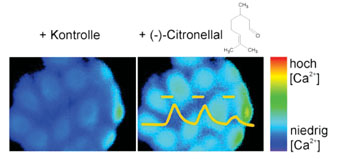Citrus Scent Found to Suppress Liver Cancer
By LabMedica International staff writers
Posted on 29 Jan 2015
Essential oils exist in many plants, protecting them through their antibacterial, antiviral, and fungicidal properties. It has been recently discovered that terpenes, the oils’ chief components, can also suppress the growth of different cancer cells, including liver cancer. Their function had not previously been fully understood. Posted on 29 Jan 2015
As main component of essential oils, terpenes can inhibit the growth of different cancer cells. Researchers from the Ruhr-University Bochum (Germany), led by Prof. Dr. Hanns Hatt, have comprehensively studied this process in liver cancer cells. They provide clues into the molecular processes that resulted in cancer cells stop growing, following the application of (-)-citronellal, and they demonstrated that the olfactory receptor OR1A2 is the key molecule for that purpose. In the future, the olfactory receptor could serve as target for liver cancer diagnosis and therapy. The researchers report their findings January 15, 2015, in the journal Archives of Biochemistry and Biophysics.

Image: The calcium influx into the liver carcinoma cell can be monitored following the exposure to citronellal (pictured in pseudo-colors) (Photo courtesy of Ruhr-University Bochum).
Terpenes can initiate signaling processes in cells by activating olfactory receptors. Those receptors are mainly located in the nose, but they have been proved to occur in all types of human tissue, including skin, prostate, and spermatozoa. Carcinogenesis and cancer growth are similarly considerably affected by terpenes, even though it has not been understood which function they fulfil.
To determine this, the researchers from Bochum employed a cellular model of hepatocellular carcinoma, a common liver tumor. They exposed the cells to a subset of terpenes with different concentrations, and monitored their reactions. It emerged that two of the 11 terpenes evaluated resulted in a substantial increase in calcium concentration in the cells: (-)-citronellal and citronellol. During a follow-up analysis, the researchers focused on (-)-citronellal and scanned for a receptor into which the terpene has to fit like a key into a lock.
The scientists demonstrated that the decisive olfactory receptor OR1A2 occurs in liver cells and is responsible for detection of the citrus scent and cellular reaction. If the option for producing that receptor had been removed from the cells, they did no longer react to the terpene. The researchers, moreover, succeeded in monitoring the signaling pathway that the terpene uses for increasing calcium concentration inside the cells, thereby decreasing cell growth. “These results are yet another example for the significance of olfactory receptors outside the nose, and they give rise to hope that new drugs with no severe side effects may be developed for cancer therapy,” the authors reported.
The hepatocellular carcinoma is the most common primary tumor of the liver. It is the third most common tumor-induced cause of death.
Related Links:
Ruhr-University Bochum













